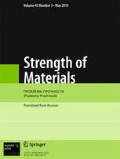This study aims to establish an effective method for predicting the fatigue life of an automotive wheel in the accelerated dynamic cornering fatigue test. The test was simulated by linear transient dynamic finite element analysis, in which a rotating force of constant magnitude was applied to the moment arm tip to simulate the rotational bending effect on the wheel, with the wheel being fixed. Furthermore, transient strain histories of the elements were obtained and the critical elements with the largest amplitudes in their respective steady radial strain histories were found. The steady radial strain histories of all the critical elements were processed based on the local stress-strain approach, and the shortest simulated fatigue lives were taken as the predicted wheel fatigue lives. The predicted fatigue life was in good agreement with the average real-world test life of the investigated wheel.





















Similar content being viewed by others
References
R. Shang, W. Altenhof, H. Hu, and N. Li, “Rotary fatigue analysis of forged magnesium road wheels,” SAE Int. J. Mater. Manuf., 1, No. 1, 9–15 (2009), https://doi.org/https://doi.org/10.4271/2008-01-0211.
SAE Handbook, Society of Automotive Engineers, Inc., Warrendale (1982).
X. Wang and X. Zhang, “Simulation of dynamic cornering fatigue test of a steel passenger car wheel,” Int. J. Fatigue, 32, No. 2, 434–442 (2010).
U. Kocabicak and M. Firat, “Numerical analysis of wheel cornering fatigue tests,” Eng. Fail. Anal., 8, No. 4, 339–354 (2001).
Z.-G. Zheng, T. Sun, X.-Y. Xu, et al., “Numerical simulation of steel wheel dynamic cornering fatigue test,” Eng. Fail. Anal., 39, 124–134 (2014).
M. Riesner and R. I. DeVries, Finite Element Analysis and Structural Optimization of Vehicle Wheels, SAE Technical Paper 830133 (1983), https://doi.org/https://doi.org/10.4271/830133.
H. Karandikar and W. Fuchs, Fatigue Life Prediction for Wheels by Simulation of the Rotating Bending Test, SAE Technical Paper 900147 (1990), https://doi.org/https://doi.org/10.4271/900147.
D. Radaj, Design and Analysis of Fatigue-Resistant Welded Structures, Woodhead Publishing Ltd., Cambridge (1990).
Dowling, N., A Discussion of Methods for Estimating Fatigue Life, SAE Technical Paper 820691 (1982), https://doi.org/https://doi.org/10.4271/820691.
H. Reemsnyder, Constant Amplitude Fatigue Life Assessment Models, SAE Technical Paper 820688 (1982), https://doi.org/https://doi.org/10.4271/820688.
D. Socie, Variable Amplitude Fatigue Life Estimation Models, SAE Technical Paper 820689 (1982), https://doi.org/https://doi.org/10.4271/820689.
Author information
Authors and Affiliations
Corresponding author
Additional information
Translated from Problemy Prochnosti, No. 4, pp. 184 – 205, July – August, 2020.
Rights and permissions
About this article
Cite this article
Dong, Z.C., Wang, X.F., Zhang, X.G. et al. Fatigue Life Prediction for the Steel Passenger Car Wheel in the Dynamic Cornering Fatigue Test. Strength Mater 52, 662–682 (2020). https://doi.org/10.1007/s11223-020-00217-3
Received:
Published:
Issue Date:
DOI: https://doi.org/10.1007/s11223-020-00217-3




